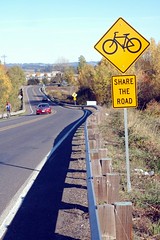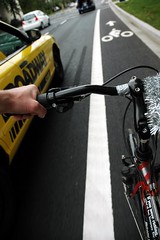
The article below was written by Christopher Heaps. Heaps is a Sellwood resident who rides his bike daily to his job as a lawyer with Stoel Rives in downtown Portland.
You might remember Heaps as the lawyer who garnered a headline or two for successfully carrying out the “citizen-initiated citation” process. We wrote about Heaps earlier this month because he’s representing two men who feel they were wrongly cited in the Ainsworth Incident.
In the article below, Heaps shares his thoughts on why he thinks Portland should adopt a new safe passing ordinance.
Portland Needs a Safe Passing Distance Ordinance
By now you’ve probably read about the Ainsworth Incident, in which Portland Police Bureau Officer Jimmy Pryce passed a cyclist “within a foot” of their handlebars while driving his police car. Several important issues were raised by this incident, but perhaps the most fundamental — for those of us making our way around Portland on two wheels every day — is, “Isn’t this a violation of Oregon law?”

by Multonomah County.
Being a lawyer (disclaimer: I am also representing the cyclists in the aforementioned incident), I want to make clear that I’m not giving any legal advice here, I’m merely expressing my opinion that operating a motor vehicle so as to cause it to pass within a foot of a bicyclist’s handlebars is indeed a violation of Oregon’s Vehicle Code.
So … what’s the violation?
The first place you might look is the legislation passed in 2007 that led to Oregon Revised Statute (ORS) 811.065 (see this page for all the statutes referenced in this article). That law provides for a traffic offense known as “unsafe passing of a person operating a bicycle.” It requires drivers to pass bicyclists at a “safe distance,” and defines the term “safe distance” to mean
“a distance that is sufficient to prevent contact with the person operating the bicycle if the person were to fall into the driver’s lane of traffic.”
That sounds exactly like what Officer Pryce is alleged to have done, right?
Unfortunately, the law contains a broad exception that applies on virtually all streets where bicyclists ride, making the law – in my humble opinion – virtually worthless. A driver cannot commit the traffic violation of “unsafe passing of a person operating a bicycle” if the driver is going 35 mph or less. Yes, really.

law applies only to rural roads
with speeds over 35 mph, like
this one in North Plains.
(Photos © J. Maus)
Simply put, it makes no sense that this exception is in the law. As I mentioned, the speed limit will be 35 or less virtually everywhere bicyclists ride. The law is only applicable on rural roads, and Portland doesn’t have any of those. This law does not help Portland’s bicyclists at all. Nor does is help anyone riding virtually anywhere in any of Oregon’s towns.
We all know speed is dangerous. One could argue that it’s not as dangerous to pass a bicyclist within the prescribed distance when going slower than 35 mph. But, as anyone who rides around our fair City (or any other) can tell you, it’s dangerous to pass someone that closely even at 15 mph. It’s so close that even the slightest miscalculation or unforeseen event could cause the bicyclist’s death or severe injury.
So, why shouldn’t this infraction apply regardless of speed?
I’ve asked this question of some people who are familiar with the legislative history of this rule, and I was told that it is the product of a political compromise in which TriMet felt that its bus drivers should not be required to give bicyclists this much room when passing them*.
[*Editor’s note: In a story published here two years ago, a TriMet spokesperson expressed concerns about a passing distance law in downtown “where streets are very narrow.”]
“If we really want to encourage people to get on their bikes and ride around Portland … we need a specific standard that everyone can understand, a standard that protects bicyclists from the risk of being killed by people trying to save a few seconds on their drive.”
In addition, it’s very difficult to prove how fast a driver was actually going without the benefit of police radar. That means it’s virtually impossible to cite a driver for this violation without the benefit of a speed trap. The rule requiring safe passing should not require proof of the motor vehicle’s speed. Further, it should be based on a clear standard for what distance is far enough (such as the “fall-over” standard in ORS 811.065).
When I first started riding on the streets of Seattle and a motorist gave me a very close pass, I was terrified. I considered never riding on the roads again. It frightened me so much because I knew I could have been killed instantly. And there are only two reasons drivers do this; either they’re oblivious to the risk they’ve created or they’re trying to send that very message to you. That message is, get out of my way and stay off the roads so you don’t slow me down.
Do we want our laws to help those few dangerous drivers to send that message?
Now, if you’re thinking about the Ainsworth Incident, you’re asking, “Was Officer Pryce going 35+ mph?” To answer that question you first have to ask: What evidence of his speed is there? As I mentioned above, it’s a difficult thing to prove. And knowing Officer Pryce’s speed isn’t important to the point of this editorial anyway. One point is that ORS 811.065 is of limited value – the proverbial bone thrown to a few concerned activists (thank you!) who showed up in Salem and told stories about how people riding on rural roads were killed by aggressive drivers trying to pass them.
ORS 811.065 does nothing to address the numerous, and often unreported, incidents that occur in Portland every day when drivers attempt to unsafely pass bicyclists.
So, are there any other candidates for dealing with this dangerous behavior? Yes. ORS 811.420 prohibits passing in a no passing zone. Many of us have experienced drivers passing us this way, whether it be on blind hills on the west side of Portland, on a curve out in the Gorge, or within only a few feet of an intersection around town. Unfortunately, this offense doesn’t specifically address close passing.

a more broad safe passing distance
law from being enacted.
Also, the “unsafe passing on the left” violation in ORS 811.410 requires vehicles to pass “at a safe distance.” Unfortunately, what constitutes a safe distance under this rule is not defined. That means it will be left for the judge to decide what the distance actually was – does he or she believe the police officer or the bicyclist? And, regardless of who she goes with on the facts, was that distance “safe”? Has the judge been on a bike since she was 5 years old? Can she understand what it’s like to have two tons of metal bearing down on you while you’re pedaling next to parked cars?
The judge’s predilections aside, it seems clear to me that passing within a foot of someone’s handlebars violates ORS 811.410.
The only other candidate Oregon law offers us is “careless driving,” (ORS 811.135). A driver is driving carelessly if he/she drives, “in a manner that endangers or would be likely to endanger any person or property.” Is passing within a foot of someone’s handlebars an act that endangers them? Again, it seems obvious to me that it is. But, there is no bright line in the law. So, we’re faced with the same issue of judicial discretion.
Right now, it seems that ORS 811.410 (vehicles required to pass “at a safe distance”) and 811.135 (careless driving) are all we’ve got. Do you really want to have to rely on being subjected to this sort of terror and then going to court and getting a good (ahem) lawyer to argue that what the driver did was so dangerous and irresponsible as to be illegal? Or, would you like to have a clear standard that everyone can understand? A standard like: Don’t come within 5 feet of me with your car under any circumstances.
It seems to me that, if we really want to encourage people to get on their bikes and ride around Portland – and that’s what I want – we need a specific standard that everyone can understand, a standard that protects bicyclists from the risk of being killed by people trying to save a few seconds on their drive.
You might be surprised to learn one city in Oregon has done this. You might be even more surprised to learn that it’s Grants Pass. Yep. Thanks to the work of attorney Mark Lansing and some dedicated roadies down in southern Oregon, Section 6.20.220 of the Grants Pass Municipal Code requires drivers to give bicyclists three feet of distance when passing. Pretty great, right? Five feet would be better, but still – it’s clear.
During our recent City elections, I supported two candidates (Jim Middaugh and Chris Smith) who were not elected to the City Council. I spoke with both of them about creating a city ordinance that incorporated the standard in 811.065, providing that it is unsafe and illegal to pass a bicyclist – at any speed – at less than “a distance that is sufficient to prevent contact with the person operating the bicycle if the person were to fall into the driver’s lane of traffic.” Both of them liked the idea. I think most, if not all, of our current City Commissioners would too.
If our City leaders truly want to encourage people to ride around town, they can do something very simple to remove one important daily source of fear and frustration for Portland’s bicyclists, not to mention something that will perhaps provide a key source of education for Portland’s police officers. They can enact an ordinance that tells motorists, plain and simple, to give bicyclists room.
I’m considering gathering names for a petition to our City Commissioners about this issue. What do you think? Would you join me in asking our City Council to adopt a clear and enforceable safe passing distance ordinance?



